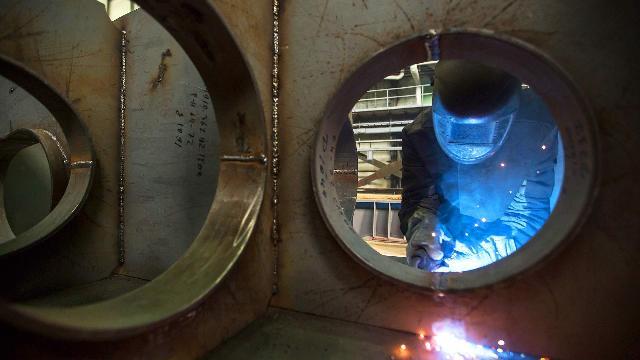Amur Shipyard is updating the infrastructure that will allow launching frigates
For the first time, the Amur Shipbuilding Plant (ASZ) will be able to build frigates. This will be possible thanks to the recently laid new floating transport dock of project 17574 Amur. The construction will allow the built large ships to be transported to Vladivostok and the waters of the Sea of Japan along the Amur River, where, due to sea precipitation, they cannot pass under their own power. About the development of shipbuilding in the east of Russia and its prospects — in the material of Izvestia.
"Amur" and "Amur"
The production facilities and technical equipment of the ASZ are suitable for the construction of ships and vessels with a launching mass of up to 10 thousand tons, a length of up to 150 m and a width of up to 19 m. The only currently available transport and launching dock "Zeya" can accept ships or vessels with a width of no more than 14 m. It turns out that large facilities can be built, but they can no longer be lowered. At the same time, the Zeya itself, built in 1991, is in "unusable" condition and belongs not to the plant, but to the Russian Navy.
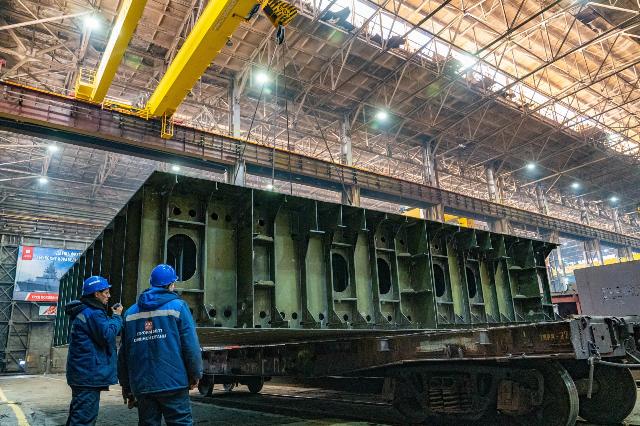
Construction of the Amur floating dock of project 65911
Image source: Photo: ASZ
Therefore, the process of reconstruction of the dock facilities of the plant began. This process is taking place within the general framework of the modernization of the USC dock facilities. So, on June 30, 2023, the launching dock pontoon of project 65911 "Amurets" was laid. With the help of it, ships and vessels will be withdrawn from the boathouses. On July 5, 2024, the Amur transport and launching dock was laid down. It will replace the Zea dock and will allow the transportation of vessels and ships with an overall width of up to 23.5 m.
The commissioning of these docks will allow the ASZ to build ships and vessels of larger displacement and larger dimensions. The plant has long dreamed of building frigates of the 22350 project and can do it. The need for frigates for all four of our fleets is clearly not going to be covered by St. Petersburg's Severnaya Verf alone. It is necessary, as in the last century, to build ships for the Pacific Fleet in the Far East again. By the way, at the end of 2023, the plant received a license to build frigate-class ships.
According to the statement of General Director Mikhail Borovsky, the plant expects to receive orders for the construction of frigates, large rescue vessels to support the activities of fishing vessels, as well as an order for another batch of corvettes of the 20380/20385 family. These orders will ensure the operation of the enterprise until 2037.
The origin of shipbuilding in the east of the country
It is impossible to defend the vast expanses of the Far East from Chukotka to Primorye without a fleet. There was already a precedent when American settlers were expelled from Wrangel Island. So, it is necessary to create naval forces. And in the early 1930s, it was decided to revive the Pacific Fleet.
Initially, the Pacific Fleet was created by transferring torpedo boats, small submarines, and weapons that could be transported by rail. Along the way, civilian transports and trawlers were armed and became minelayers and minesweepers. However, these are half measures. Larger specially built warships are needed, such as cruisers, destroyers and patrol ships, as well as large submarines. To build them in the shipyards of the European part of the Soviet Union? So then it is necessary to transfer to the Far East. The Soviet navy has practically no experience of such transitions. The country is surrounded by enemies, the transition can end tragically. The Northern Sea Route? It is still at the beginning of the study. So it is necessary to build shipbuilding plants in the Far East.
The first question is: where to build? Vladivostok — the Japanese are nearby. A special commission went to look for sites. We found a good place near Khabarovsk, but for a number of reasons it did not fit. We need to look for another place. He was found near the village of Permskoye in the Nizhne-Tambov region of the Far Eastern Territory.
Izvestia's help
On August 31, 1931, the Council of Labor and Defense identified a place for the shipyard at the confluence of the Amur and Ussuri rivers near the village of Nizhne-Voronezhsky, 14 km from Khabarovsk.
Japan's seizure of Manchuria made it necessary to think about moving the construction site away from the border. The determining factor in changing the construction site and the purpose of the new site in the village of Permsky was that the village was located at a distance of 400 km from the border with China (the maximum possible flight range of Japanese aircraft of that time).
On February 19, 1932, a government commission under the leadership of the deputy chairman of the Revolutionary Military Council, Jan Gamarnik, chose the Permskoye village as the location of the plant, which was named Amur Shipyard.
On June 12, 1933, the solemn laying of the first industrial facility of the Amur Shipyard, the hull processing workshop, took place.
The next question is: how to build ships? The technologies of inclined slipways, widely used then, and even now, were not suitable for the amplitude of fluctuations of the Amur River in 10-12 m. Then the shipbuilder Vladimir Kostenko proposed a new technology. By the way, under the name of engineer Vasiliev, he was bred by Alexey Novikov-Priboy in the novel "Tsushima".
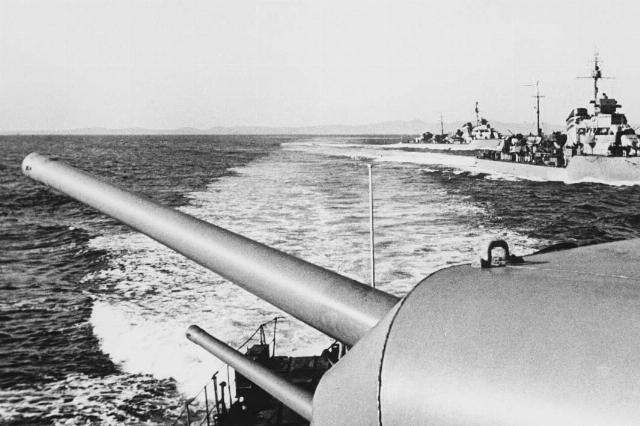
Soviet ships of the Pacific Fleet on a combat mission, 1945
Image source: Photo: RIA Novosti/Leon Dubilt
So, Kostenko proposed to build horizontal slipways in bulk docks, covered with heated boathouses. It was possible to carry out construction in any weather conditions, including winter. After the ship reaches a certain degree of readiness, water is poured into the docks, and the ship floats up. It is taken out to the filling pool, then put to the completion embankment, where the next stage of construction is carried out. In the future, the ship is towed to the mouth of the Amur River and transferred to Vladivostok, where work is being completed at the completion base of the plant. The ship undergoes the necessary complex of tests and is transferred to the fleet. According to the same principle, only on a somewhat large scale, the Sevmash plant in Severodvinsk was later built.
The Amur Shipyard began construction in 1933. Where there is a factory, there are people, where there are people, there is a city. This is how Komsomolsk-on-Amur appeared. Thus, the issue of national economic development of the Far East was also solved through military projects. In parallel, the Komsomolsk-on-Amur Aviation Plant, which now produces Su-35S and Su-57 fighters, began to be built.
The first ship laid down at the shipyard was the 26 bis Kalinin cruiser, the construction of which began on June 12, 1938. It was handed over to the Navy on December 31, 1942. Since the 1950s, the plant began to build both submarines and vessels for civilian purposes.
With the beginning of the nuclear era, the plant began to create nuclear submarines. With the growing mass of ships under construction, it was necessary to change the technology of their withdrawal. The plant underwent reconstruction, ships, vessels and submarines began to be withdrawn from the boathouses by ship train to the transport and ship dock. So the ship was launched, lowered again and completed. Later, the dock was moved to the completion base.
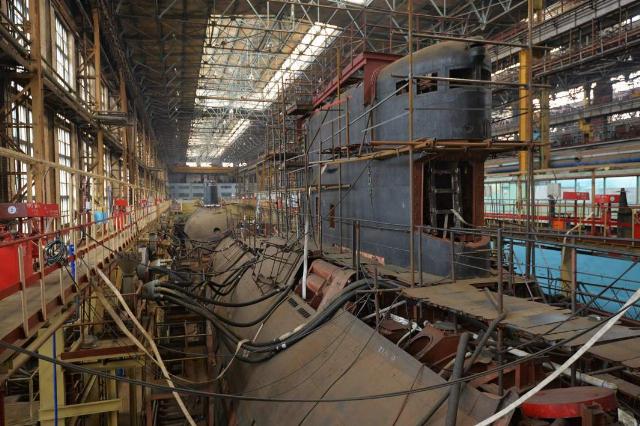
Amur Shipbuilding Plant
Image source: Photo: RIA Novosti/Sergey Mamontov
In general, by the early 1990s, the ASZ provided two-thirds of the Pacific Fleet with nuclear and diesel submarines. In total, the Amur Plant has built 57 nuclear and 42 diesel-electric submarines.
Only such large ones as the missile boats of the 667BDR project and the shock boats of the 949A project were built on Sevmash. However, large warships of the 1st and 2nd rank for the Pacific Fleet were built in the western part of the Soviet Union. They were too big for the ASZ.
A new stage
In the 1990s, the plant practically lost its state defense order. It was privatized, passed from hand to hand and was generally in very poor condition. With great difficulty, in 2009, the plant completed and handed over to the Indian Navy the K-152 submarine of project 971, which became the penultimate completed boat from the Soviet reserve.
In the early 2000s, the situation with the naval personnel of the Pacific Fleet was worse than ever. A missile cruiser, four large anti-submarine ships and a destroyer were in service. A pale shadow from the might of the 1991 TOPH.
At that time, the first Russian project of a relatively large warship, the corvette project 20380, had already appeared. We decided to build them on the ASZ for the TOP. In 2006, the corvette "Perfect" was laid down. The construction was so-so. It should be noted that the delivery of ship mechanisms and equipment from the European part of the country to Komsomolsk increases the cost of the ship. By the way, the same thing happened in Soviet times. The second corvette "Loud" was laid down in 2012. It took radical efforts on the part of both the federal and local authorities to resolve all issues, including visits by top officials of the state. In 2010, the plant was transferred under the control of the United Shipbuilding Corporation.
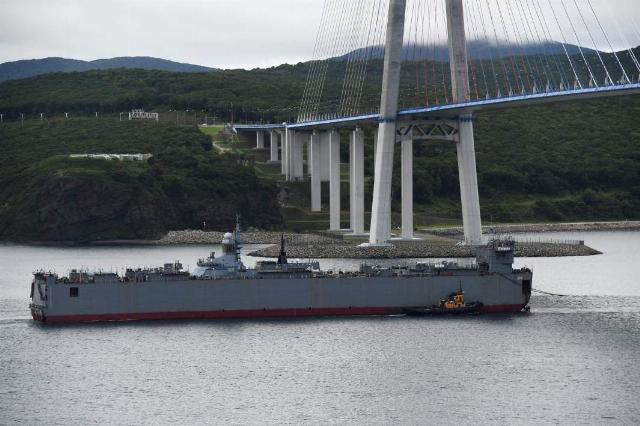
Towing of the floating dock "Zea" with the corvette "Loud" located in it
Image source: Photo: RIA Novosti/Vitaly Ankov
And the process started. If the "Perfect" was built for 11 years, then the subsequent ones were surrendered in five to six years. At the same time, the corvettes were taken out of the workshops first with the help of the Zey dock, then from the dock to the water, they were placed against the finishing wall. After carrying out a certain stage of work, they were docked again and then the dock with the corvette inside was towed along the Amur River to the Pacific Ocean, then to Vladivostok. The dock is needed to overcome the rifts on the Amur River. Vessels with a shallower draft are transferred without it.
This made it possible to increase the ship composition of the Pacific Fleet by almost two times. In 2024, it includes a cruiser, a frigate, three large anti-submarine ships and five corvettes, four of which are built at the ASZ. In addition to warships, ferries for communication with Sakhalin Island, supply vessels for drilling rigs, and rescue vessels have been built at the plant in recent years.
The Ministry of Defense and the Navy believed in the capabilities of the plant, as a result, it received contracts in 2018 for the construction of four small missile ships of the 22800 Karakurt project. And in 2020— a contract for the construction of two corvettes of project 20380 and four of project 20385 with deadlines until the end of 2028. In addition to 10 warships, two civilian vessels are currently being built at the plant.
Dmitry Boltenkov
